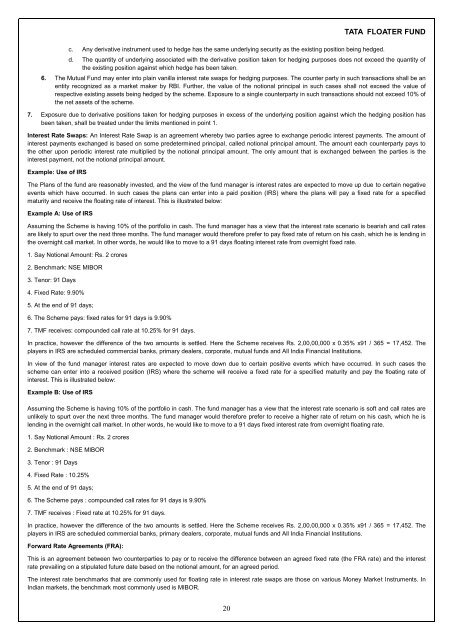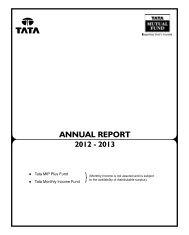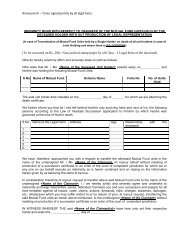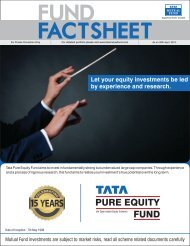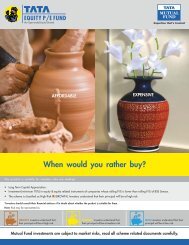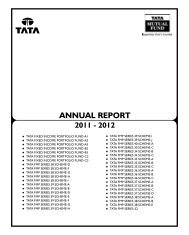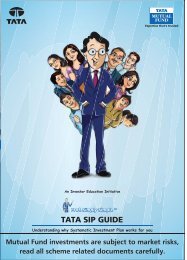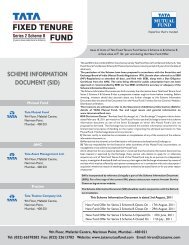Front Cover Page - Tata Mutual Fund
Front Cover Page - Tata Mutual Fund
Front Cover Page - Tata Mutual Fund
Create successful ePaper yourself
Turn your PDF publications into a flip-book with our unique Google optimized e-Paper software.
c. Any derivative instrument used to hedge has the same underlying security as the existing position being hedged.<br />
TATA FLOATER FUND<br />
d. The quantity of underlying associated with the derivative position taken for hedging purposes does not exceed the quantity of<br />
the existing position against which hedge has been taken.<br />
6. The <strong>Mutual</strong> <strong>Fund</strong> may enter into plain vanilla interest rate swaps for hedging purposes. The counter party in such transactions shall be an<br />
entity recognized as a market maker by RBI. Further, the value of the notional principal in such cases shall not exceed the value of<br />
respective existing assets being hedged by the scheme. Exposure to a single counterparty in such transactions should not exceed 10% of<br />
the net assets of the scheme.<br />
7. Exposure due to derivative positions taken for hedging purposes in excess of the underlying position against which the hedging position has<br />
been taken, shall be treated under the limits mentioned in point 1.<br />
Interest Rate Swaps: An Interest Rate Swap is an agreement whereby two parties agree to exchange periodic interest payments. The amount of<br />
interest payments exchanged is based on some predetermined principal, called notional principal amount. The amount each counterparty pays to<br />
the other upon periodic interest rate multiplied by the notional principal amount. The only amount that is exchanged between the parties is the<br />
interest payment, not the notional principal amount.<br />
Example: Use of IRS<br />
The Plans of the fund are reasonably invested, and the view of the fund manager is interest rates are expected to move up due to certain negative<br />
events which have occurred. In such cases the plans can enter into a paid position (IRS) where the plans will pay a fixed rate for a specified<br />
maturity and receive the floating rate of interest. This is illustrated below:<br />
Example A: Use of IRS<br />
Assuming the Scheme is having 10% of the portfolio in cash. The fund manager has a view that the interest rate scenario is bearish and call rates<br />
are likely to spurt over the next three months. The fund manager would therefore prefer to pay fixed rate of return on his cash, which he is lending in<br />
the overnight call market. In other words, he would like to move to a 91 days floating interest rate from overnight fixed rate.<br />
1. Say Notional Amount: Rs. 2 crores<br />
2. Benchmark: NSE MIBOR<br />
3. Tenor: 91 Days<br />
4. Fixed Rate: 9.90%<br />
5. At the end of 91 days;<br />
6. The Scheme pays: fixed rates for 91 days is 9.90%<br />
7. TMF receives: compounded call rate at 10.25% for 91 days.<br />
In practice, however the difference of the two amounts is settled. Here the Scheme receives Rs. 2,00,00,000 x 0.35% x91 / 365 = 17,452. The<br />
players in IRS are scheduled commercial banks, primary dealers, corporate, mutual funds and All India Financial Institutions.<br />
In view of the fund manager interest rates are expected to move down due to certain positive events which have occurred. In such cases the<br />
scheme can enter into a received position (IRS) where the scheme will receive a fixed rate for a specified maturity and pay the floating rate of<br />
interest. This is illustrated below:<br />
Example B: Use of IRS<br />
Assuming the Scheme is having 10% of the portfolio in cash. The fund manager has a view that the interest rate scenario is soft and call rates are<br />
unlikely to spurt over the next three months. The fund manager would therefore prefer to receive a higher rate of return on his cash, which he is<br />
lending in the overnight call market. In other words, he would like to move to a 91 days fixed interest rate from overnight floating rate.<br />
1. Say Notional Amount : Rs. 2 crores<br />
2. Benchmark : NSE MIBOR<br />
3. Tenor : 91 Days<br />
4. Fixed Rate : 10.25%<br />
5. At the end of 91 days;<br />
6. The Scheme pays : compounded call rates for 91 days is 9.90%<br />
7. TMF receives : Fixed rate at 10.25% for 91 days.<br />
In practice, however the difference of the two amounts is settled. Here the Scheme receives Rs. 2,00,00,000 x 0.35% x91 / 365 = 17,452. The<br />
players in IRS are scheduled commercial banks, primary dealers, corporate, mutual funds and All India Financial Institutions.<br />
Forward Rate Agreements (FRA):<br />
This is an agreement between two counterparties to pay or to receive the difference between an agreed fixed rate (the FRA rate) and the interest<br />
rate prevailing on a stipulated future date based on the notional amount, for an agreed period.<br />
The interest rate benchmarks that are commonly used for floating rate in interest rate swaps are those on various Money Market Instruments. In<br />
Indian markets, the benchmark most commonly used is MIBOR.<br />
20


